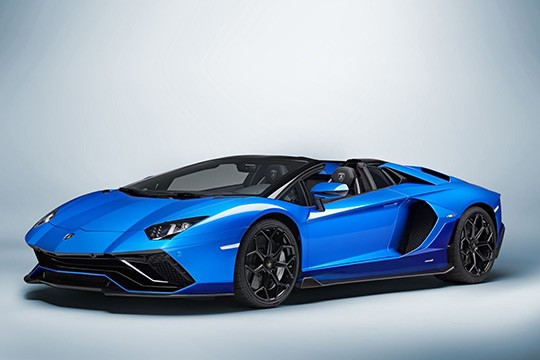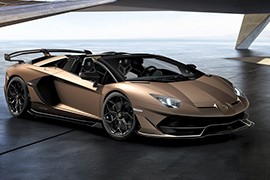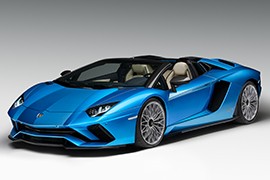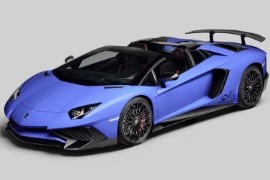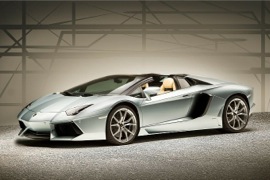LAMBORGHINI Aventador Roadster Models/Series Timeline, Specifications & Photos
First production year: 2012
Engines: Gasoline
Body style: Convertible (spider/spyder, cabrio/cabriolet, drop/open/soft top)
It was the last roadster built by Lamborghini with the marvelous, naturally aspirated V12 engine behind the cabin, and it offered the thrills its customers asked for.
As the world started to shift toward electric-powered vehicles, some carmakers tried to keep the old-fashioned gasoline-only powered supercars on the assembly lines. One of them was Lamborghini, who released a last special edition of the 11-year-old Aventador, and it was named Ultimae Roadster. No, there is no spelling mistake there; Ultimae is the Italian word for, you guessed it, ultimate.
While it wasn't a completely new car, the Ultimae roadster shared many of its parts with the open-top Aventador but sported a few unique details. For instance, the front bumper featured a wider air intake that increased the downforce on the front axle. Moreover, the carmaker adorned the side air intake with unique details that made the bystanders understand that it is the ultimate Aventador in terms of performance. At the back, the three-position wing increased the downforce and helped the car stay planted to the road.
The cabin sported a similar environment to its coupe sibling. The Y-shaped pattern on the seat's upholstery emphasized the car's sports character. On the other hand, unlike the coupe, the roadster didn't offer the same contrast lines on the seatbacks, only the contrast stitching.
Featuring the same naturally aspirated V12 engine as the Aventador Ultimae, the Roadster version was 50 kg (110 lbs) heavier than its sibling. Still, that didn't really affect the car's performance. It just added more excitement to its driver.
LAMBORGHINI LP780-4 Ultimae Roadster 6.5L V12 7AT AWD (780 HP)
The Aventador SVJ Roadster was presented for the first time at the 2019 Geneva Motor Show. It is the kind of vehicle that someone can enjoy with only one other person, just like the regular SVJ version, but now with an open top for a more exhilarating experience.
The open-top version of the SVJ features the same technical details as its hardtop record-breaking brother, which covered the Nurburgring-Norschleife in 6m44s97”. The V12 engine screaming behind the passengers is a 6.5-liter (396.6 cu-in), naturally aspirated unit. The maximum power offered by the SVJ is 770 hp and 720 Nm (568 lb-ft) of torque. The transmission is all-wheel-drive and the gearbox is a single-clutch 7 speed unit.
For the bodywork, the SVJ Roadster keeps the same ALA (Aerodinamica Lamborghini Attiva – Lamborghini Active Aerodynamic) system as the coupe version. Lamborghini officials state that the vehicle offers the same aerodynamic downforce regardless if the top is open or closed. The ALA system has a number of active, computer-controlled flaps that opens and close depending on the speed and steering inputs, increasing the massive wheels' traction. The SVJ Roadster is offered with specially designed Pirelli P-Zero Corsa with optional semi-slick (but still road-legal) Pirelli P-Zero Trofeo R tires.
Performance numbers match the manufacturer's name. The 0-100 kph (0-62 mph) sprint is done in 2.9 seconds and the car has a top speed of 351 kph (218 mph).
The Aventador S Roadster stepped into it's brother shoes, but with a retractable cap on its head. It also wear slightly different clothes too.
After it was taken over by the Volkswagen Group, the Lamborghini car-maker started to increase its model range and to diversify each and every model it had on its stable. After six years since it was launched the Aventador received an important upgrade with the S version.
The roadster maintains the unmistakable design of the Aventador S (coupe) along with unique features reflecting its roadster personality: a combination of distinctive Lamborghini design DNA and the result of extensive aerodynamic testing. In the back, the roadster distinctively featured different lines then the coupe, offering its aerodynamic character. An engine bridge runs from the rear window to the back, in a mix of body color and black painted carbon fiber engine hood blades: a transparent option was also available to show off the V12 engine within.
The interior was not very much changed. It still looked like a cockpit from a fighter-jet, with toggle switches and a flap above the engine start button. The bucket-seats were covered in leather and bolstered for side support. The infotainment unit was little upgraded from the original, 2011, Aventador.
The most important was the 6.5-liter V12 engine placed in front of the rear axle. It was mated to a standard Lamborghini lightweight Independent Shifting Rod (ISR) 7-speed shifting system. The all-wheel-drive and all-wheel-steering super-car was able to hit the 60 mph (96 kph) in under three seconds.
Lamborghini released the 500-units limited-series Aventador 570-4 Superveloce Roadster at the 2015 Monterey Car week in California.
If its coupe sibling was the darling of those who tried it on the track, the Roadster version was built for those who tried to enjoy life at every corner. For those who didn't care too much about lap times but about fun on each lap they ran. But don't think that the 570-4 SV Roadster was slow. It was just slower than its coupe sibling due to the added weight and the lower rigidity of the chassis.
The name said it all: 750 hp and all-wheel-drive. The SV meant Superveloce, which can be translated into Superfast. To live up to that name, the Lamborghini engineers added 50 more hp to the Aventador LP 700-4 Roadster and cut 50 kg (110 lbs) from its weight. It wasn't only a diet but a training program. While the removal of the ALA (Lamborghini Active Aerodynamic) cut some weight, then added some kilos in the form of adaptive steering and magnetorheological dampers.
Lamborghini also focused on the car's interior and offered not only a sporty look but preserved a luxurious appearance as well. Thus, the yellow display on the instrument cluster with black dials formed helped the driver to easily read the information regarding the speed and the revs. Yet, the sports bucket seats featured contrast stitching and high-quality materials that also gave the occupants a feeling of a luxurious roadster. For better open-top experiences, the automaker installed a rear window, thus lowering the wind turbulence inside the cockpit.
Even though it was 50 kg heavier than its coupe sibling, the Superveloce Roadster was just .1 seconds slower than that in the 0-100 kph (0-62 mph) run. Yet, the top speed was the same.
LAMBORGHINI Aventador LP750-4 SV Roadster 6.5L V12 7AT (750 HP)
After the successful launch of the Aventador in 2011, Lamborghini worked another year to develop and launch the roadster version, which was just a little bit heavier, but as fast as the coupe.
On normal convertible vehicles, when the constructor takes the roof off, it has to add more weight to the chassis to improve the car's rigidity. For the Aventador roadster, the Lamborghini had to add 50 kg (110 lbs), which means nothing for the 700 hp engine. To prove that, the Lamborghini engineers took the car to the Nardo race-track in Southern Italy and showed a top speed of 220 mph (354 kph) with the top down.
The look of the Aventador roadster is the same in the front and rear. Only the middle changed a bit by removing the roof. It is a two-piece, carbon-fiber roof that can be taken out and stored in the front trunk. The engine was placed in the rear-mid position and it was covered with four oddly-shaped glass panels to improve the cooling and to allow the view to the 12 cylinder masterpiece.
Inside, the stealth-fighter jet inspiration design was obvious, from the bucket seats to the cockpit layout. It is hard to call that arrangement as a dashboard, with its extended and risen center console. Some buttons and switches are directly taken from Audi, which might look awkward for a supercar like the Aventador.
The seven-speed automatic single-clutch gearbox was quick and lighter than a double-clutch one. The traction mode could be adjusted via two buttons on the center console from the street use, to track mode. That could send the torque from a split 30:60 to a 10:90 percentage.
